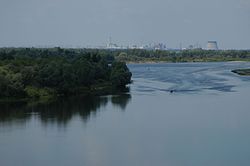Pripyat (river)
| Pripyat Prypiat, Prypiać, Prypeć | |
|---|---|
 Pripyat River | |
 Course of the Pripyat River | |
 | |
| Location | |
| Country | Ukraine, Belarus |
| Physical characteristics | |
| Source | |
| • location | Volyn Oblast, Ukraine |
| • coordinates | 51°20′00″N 23°47′26″E / 51.3333°N 23.7905°E |
| Mouth | Dnieper |
• location | Kyiv Reservoir |
• coordinates | 51°09′31″N 30°29′27″E / 51.15861°N 30.49083°E |
| Length | 761 km (473 mi) |
| Basin size | 121,000 km2 (47,000 sq mi) |
| Discharge | |
| • average | 377 m3/s (13,300 cu ft/s) |
| Basin features | |
| Progression | Dnieper→ Dnieper–Bug estuary→ Black Sea |
| Tributaries | |
| • left | Pina, Yaselda, Tsna, Lan, Sluch, Ptsich, Brahinka |
| • right | Turiya, Stokhid, Styr, Horyn, Stsviha, Ubort, Zhelon, Slovechna, Uzh |
The Pripyat or Prypiat[a] is a river in Eastern Europe. The river, which is approximately 761 km (473 mi) long,[1] flows east through Ukraine, Belarus, and into Ukraine again, before draining into the Dnieper at Kyiv Reservoir.
Name etymology
[edit]Max Vasmer notes in his etymological dictionary that the historical name of the river mentioned in the earliest East Slavic document, the Primary Chronicle, is Pripet' (Припеть), and cites the opinion of other linguists that the name meant "tributary", comparing with Greek and Latin roots. He also rejects some opinions which were improperly based on the stem -пять -pjat', rather than original -петь.[2]
The name may also derive from the local word pripech used for a river with sandy banks.[3]
Geography
[edit]The Pripyat begins in the Volhynian Upland, between the villages of Budniki and Rohivi Smoliary in Volyn Oblast, Ukraine. 204 km downstream, it crosses the border of Belarus, where it travels 500 km through Polesia, Europe's largest wilderness, within which lie the vast sandy wetlands known as the Pripet Marshes, a dense network of swamps, bogs, rivers and rivulets within a forested basin. For the last 50 kilometers the Pripyat flows again in Ukraine and flows several kilometers south of Chernobyl into the Kyiv Reservoir.[4][5]
The length of the river is 775 km, and the area of the watershed is 114,300 km2.[6] The width of the floodplain varies from 4 to 15 km over the course of the river, with occasional flooding reaching 30 km.[7][8] 495 km (308 mi) of the whole river length lies within Belarus, with the rest in Ukraine.[1]
The Pripyat is navigable up to Pinsk, where the Dnieper-Bug Canal leads to the Bug River.[6]
The Pripyat passes through the exclusion zone established around the site of the Chernobyl nuclear disaster. The nearby city of Pripyat, Ukraine (population 45,000), which was named after the river, was completely evacuated after the Chernobyl disaster.[9]
The Pripyat is known for its numerous oxbow lakes and channels.[10][11]
Dredging for E40 waterway
[edit]Dredging of the river started in 2020 to enable the E40 waterway to pass through the area. The dredging raised concerns about radioactive contamination around the Chernobyl nuclear power plant, as the river comes within 2.5 km (1.6 mi) of the nuclear reactor.[12]
See also
[edit]Notes
[edit]- ^ /ˈpriːpjət, ˈprɪp-/ PREE-pyət, PRIP-yət, Ukrainian: Прип'ять, IPA: [ˈprɪpjɐtʲ]; Belarusian: Прыпяць, romanized: Prypiać, IPA: [ˈprɨpʲat͡sʲ]; Polish: Prypeć, IPA: [ˈprɨpɛtɕ]; Russian: Припять, IPA: [ˈprʲipʲɪtʲ] ⓘ.


References
[edit]- Припять, Great Soviet Encyclopedia
- Pripyat // Dictionary of Contemporary Geographical Names / Rus. geogr. oh Moscow center; By common. Ed. acad. V. M. Kotlyakova. Institute of Geography, Russian Academy of Sciences. - Yekaterinburg: U-Factorium, 2006.
- Joint River Management Program. Final Report: River Pripyat Basin (February 2004)
- ^ a b "Main Geographic Characteristics of the Republic of Belarus. Main characteristics of the largest rivers of Belarus". Land of Ancestors. Data of the Ministry of Natural Resources and Environmental Protection of the Republic of Belarus. 2011. Archived from the original on 15 January 2014. Retrieved 27 September 2013.
- ^ Max Vasmer, Etymological dictionary of the Russian language, article "Припять" in Russian translation
- ^ Room, Adrian (1997). Placenames of the World. Jefferson, North Carolina: McFarland. ISBN 978-0-7864-0172-7.
- ^ "Басейнове управління водних ресурсів річки Прип'ять (БУВР Прип'яті)". buvrzt.gov.ua. Retrieved 2025-04-03.
- ^ "Belarus Map (Physical)". Worldometer. Retrieved 2025-04-03.
- ^ a b "Pripet River | Belarus, Ukraine, Russia | Britannica". www.britannica.com. Retrieved 2025-04-02.
- ^ Vasilievich, Kozulin Alexander; Sergeevna, Beliatskaya Olga (8 November 2016). "Belarus Mid-Pripyat State Landscape Zakaznik" (PDF). Ramsar: The Convention on Wetlands. Minsk, Belarus: Ramsar Sites Information Service. Retrieved 2 April 2025.
- ^ Kirvel, Ivan; Volchak, Alexander; Parfomuk, Sergey; Kirvel, Pavel (2023-05-01). "Environmental Risks of Water Resources in the Belarusian Polesie". Limnological Review. 23 (1): 21–32. doi:10.3390/limnolrev23010002. ISSN 2300-7575.
- ^ "Pripyat city photo and text about history | Чернобыль, Припять, зона отчуждения ЧАЭС". Retrieved 2025-04-03.
- ^ "Prypiat-Stokhid National Park". Wild Polesia. Retrieved 2025-04-03.
- ^ "Prypiat-Stokhid National Nature Park". Nature Reserve Fund of Ukraine. Retrieved 2025-04-03.
- ^ Weston, Phoebe (23 December 2020). "Chernobyl fears resurface as river dredging begins in exclusion zone". The Guardian. Retrieved 2020-12-28.
Bibliography
[edit]- (in Russian, English and Polish) Ye.N.Meshechko, A.A.Gorbatsky (2005) Belarusian Polesye: Tourist Transeuropean Water Mains, Minsk, Four Quarters,
- (in Belarusian, Russian and English) T.A.Khvagina (2005) POLESYE from the Bug to the Ubort, Minsk Vysheysha shkola, ISBN 985-06-1153-7.
External links
[edit]![]() Media related to Pripyat River at Wikimedia Commons
Media related to Pripyat River at Wikimedia Commons

